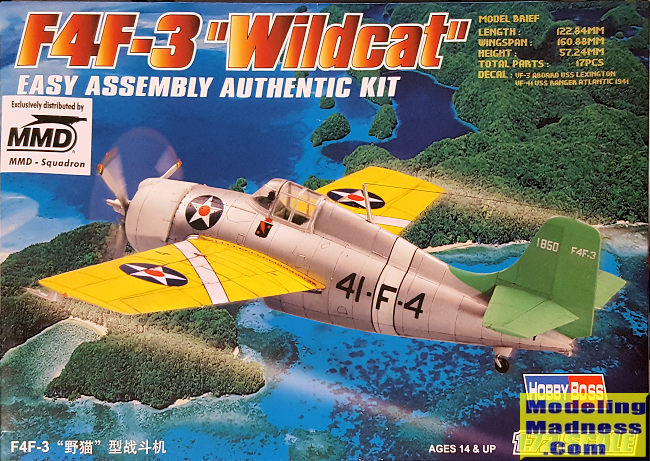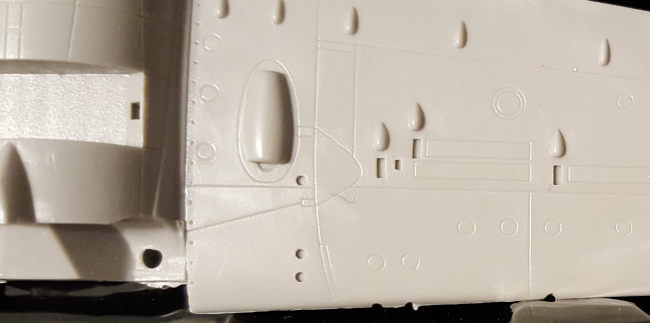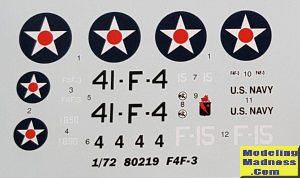
HobbyBoss 1/72 F4F-3 Wildcat
| KIT #: | 80219 |
| PRICE: | $4.00 'used' |
| DECALS: | Two options |
| REVIEWER: | Scott Van Aken |
| NOTES: | 2009 release |

| HISTORY |
With the redesign of the F4F-2 into the more powerful, P&W powered F4F-3, U.S. Navy orders followed as did some (with Wright Cyclone engines) from France; these ended up with the Royal Navy's Fleet Air Arm after the fall of France and entered service on 8 September 1940. These aircraft, designated by Grumman as G-36A, had a different cowling from other earlier F4Fs and fixed wings, and were intended to be fitted with French armament and avionics following delivery. In British service initially, the aircraft were known as the Martlet I, but not all Martlets would be to exactly the same specifications as U.S. Navy aircraft. All Martlet Is featured the four .50 in (12.7 mm) M2 Browning machine guns of the F4F-3 with 450 rpg. The British directly ordered and received a version with the original Twin Wasp, but again with a modified cowling, under the manufacturer designation G-36B. These aircraft were given the designation Martlet II by the British. The first 10 G-36Bs were fitted with non-folding wings and were given the designation Martlet III. These were followed by 30 folding wing aircraft (F4F-3As) which were originally destined for the Hellenic Air Force, which were also designated Martlet IIIs. On paper, the designation changed to Martlet III(A) when the second series of Martlet III was introduced.
Poor design of the armament installation on early F4Fs caused these otherwise reliable machine guns to frequently jam, a problem common to wing-mounted weapons of many U.S. fighters early in the war. An F4F-3 flown by Lieutenant Edward O'Hare shot down, within a few minutes, five Mitsubishi twin-engine bombers attacking Lexington off Bougainville on 20 February 1942. But contrasting with O'Hare's performance, his wingman was unable to participate because his guns would not function.A shortage of two-stage superchargers led to the development of the F4F-3A, which was basically the F4F-3 but with a 1,200 hp (890 kW) Pratt & Whitney R-1830-90 radial engine with a more primitive single-stage two-speed supercharger. The F4F-3A, which was capable of 312 mph (502 km/h) at 16,000 ft (4,900 m), was used side by side with the F4F-3, but its poorer performance made it unpopular with U.S. Navy fighter pilots. The F4F-3A would enter service as the Martlet III(B).
At the time of Pearl Harbor, only Enterprise had a fully equipped Wildcat squadron, VF-6 with F4F-3As. Enterprise was then transferring a detachment of VMF-211, also equipped with F4F-3s, to Wake. Saratoga was in San Diego, working up for operations of the F4F-3s of VF-3. 11 F4F-3s of VMF-211 were at the Ewa Marine Air Corps Station on Oahu; nine of these were damaged or destroyed during the Japanese attack. The detachment of VMF-211 on Wake lost seven Wildcats to Japanese attacks on 8 December, but the remaining five put up a fierce defense, making the first bomber kill on 9 December. The destroyer Kisaragi was sunk by the Wildcats, and the Japanese invasion force retreated.
In May 1942, the F4F-3s of VF-2 and VF-42, aboard Yorktown and Lexington, participated in the Battle of the Coral Sea. Lexington and Yorktown fought against the fleet carriers Zuikaku and Shōkaku and the light carrier Shōhō in this battle, in an attempt to halt a Japanese invasion of Port Moresby on Papua. During these battles, it became clear that attacks without fighter escort amounted to suicide, but that the fighter component on the carriers was completely insufficient to provide both fighter cover for the carrier and an escort for an attack force. Most U.S. carriers carried fewer than 20 fighters.
| THE KIT |
 Let me start right off by telling you that if you care about accuracy, you
cannot make an F4F-3 out of what comes with the kit. You need to make some
modifications as what Hobby Boss has given you is an F4F-4, the folding wing
version. Things that need to be fixed are the removal of one of the wing guns
which means filling in the gun port and ejector chute along with the ammunition
access panel. While you are at it, the panels for the folding wings also have to
be filled in. On the underside, the holes for the drop tan
Let me start right off by telling you that if you care about accuracy, you
cannot make an F4F-3 out of what comes with the kit. You need to make some
modifications as what Hobby Boss has given you is an F4F-4, the folding wing
version. Things that need to be fixed are the removal of one of the wing guns
which means filling in the gun port and ejector chute along with the ammunition
access panel. While you are at it, the panels for the folding wings also have to
be filled in. On the underside, the holes for the drop tan ks need to be filled
in as well. Moving to the cowling, if doing the second markings option, you will
probably need to remove the upper cowling scoop and add two carb intakes in the
lower cowling at about the 5 and 7 o'clock position. On the canopy, you'll
probably have to add two frame lines in the windscreen quarter windows. Check
your references on the latter two items to be sure.
ks need to be filled
in as well. Moving to the cowling, if doing the second markings option, you will
probably need to remove the upper cowling scoop and add two carb intakes in the
lower cowling at about the 5 and 7 o'clock position. On the canopy, you'll
probably have to add two frame lines in the windscreen quarter windows. Check
your references on the latter two items to be sure.
OK, now that is over, the kit itself is one of Hobby Boss' easy build kits and as such the surface detailing is very good. The wing and lower fuselage is a single piece so you may have a seam to fill. The cockpit is abbreviated but adequate for the scale. There is an engine face molded into the cowling and one simply adds the prop and its holdback. You can add the cowling after everything is painted. There are lower fuselage windows and this is accomplished by a clear piece that includes the fuselage section between them. Landing gear and nicely done and there is no gear well detail as on the real deal. Finally, you have the option of open or closed canopy, this despite the abbreviated cockpit.
 Instructions are nicely done with no color info during the build so again,
you need to check references for cockpit and gear well colors. Two markings
options are provided. One is the 'yellow wings' option as shown on the box art,
which is a VF-41 aircraft from 1941. The other is a VF-3 plane from the USS
Lexington before the battle of Midway. Inexplicably, the rudder stripes will
need to be painted on. An odd omission as nearly every kit I've ever seen with
this era of markings includes these stripes as a decal.
Instructions are nicely done with no color info during the build so again,
you need to check references for cockpit and gear well colors. Two markings
options are provided. One is the 'yellow wings' option as shown on the box art,
which is a VF-41 aircraft from 1941. The other is a VF-3 plane from the USS
Lexington before the battle of Midway. Inexplicably, the rudder stripes will
need to be painted on. An odd omission as nearly every kit I've ever seen with
this era of markings includes these stripes as a decal.
| CONCLUSIONS |
As you may have realized by now, Hobby Boss has provided an F4F-4 with F4F-3 decals. Now you have the choice of modifying the kit to meet specs, or use a set of F4F-4 decals and build the kit as it comes in the box. Even if you do a -4, you'll still need to fill the drop tank holes. If this is a gift for a youngster, then variants won't matter and they can build the kit as is with the kit decals and be none the wiser.
| REFERENCES |
https://en.wikipedia.org/wiki/Grumman_F4F_Wildcat#F4F-3
July 2021 Copyright ModelingMadness.com.
All rights reserved. No reproduction in part or in whole without express
permission. If you would like your product reviewed fairly and
fairly quickly, please
contact
the editor or see other details in the
Note to
Contributors.